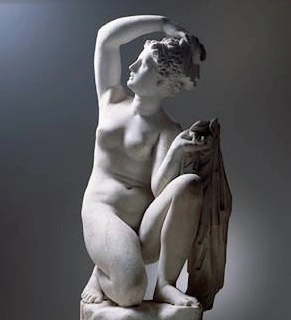Aphrodite
Publié le 22/02/2012

Extrait du document

(Foam Born) Greek Goddess of
love, beauty, and fertility. One of the 12 Olympian
Gods; identified with the Roman Venus and, much
earlier, with the Near Eastern fertility goddesses
Astarte and Ishtar. Aphrodite was an ancient deity, an
Earth Mother whose domain embraced all creation,
vegetable and animal as well as human. She represented
sacred love and marriage as well as sensuality
and desire. Aphrodite was so beautiful that all men
who saw her loved her.
The origins of Aphrodite are obscure. She is called
"Foam Born" in an attempt to make her the offspring
of Gaia (Earth) and Uranus (Heaven), who was cast
into the sea after being mutilated by his son, Cronus.
She was supposed to have emerged from the sea foam
that had formed around the remains of Uranus.
The myth of Aphrodite as a descendant of the
Titans probably refers to a goddess who preceded
the peoples later called Greeks. When the migrating
tribes settled in Greece, they adopted Aphrodite into
the Olympian family by making her the daughter of
Zeus and Dione.
According to Homer, in the Iliad, Aphrodite was the
daughter of Zeus and Dione. Also according to Homer,
Aphrodite was married to the smith god, Hephaestus.
But Aphrodite was faithless and had many lovers.
The Loves of Aphrodite Aphrodite, goddess of
love, was married to Hephaestus, but she had many
other loves, among them Ares, god of war. She bore
him Phobos (Fear), Deimos (Terror), Harmonia
(Peace or Concord) and, in some accounts, Eros
(Love).
Although Hephaestus was a god, he proved himself
capable of subtle revenge on Aphrodite and Ares
by snaring them in a skillfully crafted golden net.
Poseidon, god of the sea, fell in love with Aphrodite
when he saw her entrapped in the golden net.
With Poseidon, the goddess had two or three sons,
Rhodus and Herophilus, and, some say, Eryx.
With Hermes, a son of Zeus, Aphrodite bore
Hermaphroditus and, some say, Eros. With Dionysus,
god of the vine, another son of Zeus, she bore
Priapus. With the Trojan mortal Anchises, she bore
Aeneas.
With another mortal, the beautiful Adonis, Aphrodite
spent the months of the year that symbolized
fruitful spring and summer. Some accounts say that
she bore him a son, Golgos, and a daughter, Beroe.
From the legend of Aphrodite and Adonis comes the
word aphrodisiac, meaning a potion or other agent
that induces love.
Aphrodite was also beloved by Pygmalion, who
created a statue of her so beautiful that he fell in
love with it. And there were many other lovers, for
Aphrodite inspired love in all who saw her.
Aphrodite and Eros Aphrodite was often
depicted with the infant god, Eros (Love), who some
said was her son with Hermes. However, mythologists
believe that Eros was an ancient god, an adult
rather than a child. He was to become the plump,
babyish Cupid (his Roman name), companion or son
of Aphrodite, only in later times.
Aphrodite and Paris The tale of Aphrodite
and the young mortal hero Paris is told in Homer's
Iliad. Paris was supposed to choose the fairest among
three Olympian gods: Hera, Athene, and Aphrodite.
Each goddess offered Paris a bribe. Aphrodite offered
him the love of the most beautiful woman in the
world, and Paris awarded Aphrodite a golden apple
as reward. The beautiful woman turned out to be
Helen of Troy. The love affair of Paris and Helen
was the leading cause of the Trojan War.
Aphrodite and Art Aphrodite was worshiped
as a great beauty as well as a goddess of fertility. She
is the subject of some of the world's art masterpieces,
in which she is usually known by her Roman name,
Venus. The most famous statue of her was by the
Greek Praxiteles (c. 350 b.c.). The original has been
lost but there is a Roman copy in Athens, and the
Venus de Milo, at the Louvre, in Paris, France.
Liens utiles
- APHRODITE de LOUYS
- APHRODITE EN AULIDE (résumé & analyse) George Moore
- APHRODITE (Mœurs antiques). (résumé & analyse) de Pierre Louÿs
- Priape, e n grec Priapos, en latin Priapus, dans la mythologie grecque, fils de Dionysos et d'Aphrodite (ou d'une nymphe), dieu des jardins, de la fécondité de la nature et de la virilité.
- Aphrodite - mythologie.
